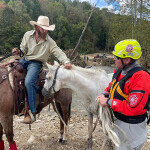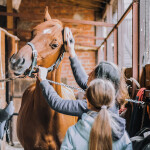A strong core in the horse has many benefits. The benefits include enhanced performance, athleticism, ability, coordination, balance, maneuverability, increased stamina and endurance, and overall health that supports circulation, digestion, and well-being which contributes to a healthier happier horse.
We have all heard the term “Legging a Horse Up,” when referring to reconditioning or building up a horse’s endurance and muscles to a more athletic state, after a period of time off, whether due to injury or just more time out in the pasture just being a horse. However, most of us have not ever really stopped and thought about the importance of making sure that our horses abdominal muscles are strong. The abdominal or core muscles are vital for providing balance, stability, and overall athletic performance, in both equines and equestrians. And just like in humans, the lack of a strong core leads to issues for the equine athlete.
A strong core in the horse has many benefits. The benefits include enhanced performance and athleticism, ability to maintain better coordination and balance and maneuverability, increased stamina, by supporting the respiratory system, improved endurance, and overall health by supporting circulation, digestion, and well-being which contributes to a healthier happier horse. Strong abdominal muscles are also necessary for a horse to engage their hind-end. As the horse is raising their hind leg, contraction of the abdominal muscles are required for the movement to occur.
According equinephysicaltherapist.co.uk, “Transforming their posture by engaging their core, stretching out the top-line, and being in a more ‘submissive’ lower neck position can actually take your horse out of flight mode - another benefit. And once this has happened, the more ‘flighty’ type of horse can actually relax properly, and then you have access to their brain - all from core engagement!” That is something equestrians from every discipline desires to achieve.
You may be asking yourself, what do I need to do to increase my horse’s core strength? Just like in humans, mobility, balance, and strengthening exercises are the basis for a strong core.
Mobility exercises include having the horse reach for a treat by putting his chin between his knees, to his chest, to his girth line, to his flank and toward his rear fetlock on each side. Balance exercises can be as simple as performing the mobility exercises with one hoof lifted. This forces the horse to engage core muscles to maintain his balance while stretching into the position that you ask.
Basic core strengthening exercises from the ground include the belly lift exercise, and the hind end tuck. To perform the equine belly lift, place your palms flat on the horses belly just behind the where the girth goes, bend your fingers and apply pressure until the horse lifts up his belly. You should see his topline rise and lengthen. This also causes the horse to tighten his abdominal muscles. Once the desired tightening of the abdominal muscle and lifting of the spine occurs, hold this position for 10 to 30 seconds. The hind end tuck, also promotes core muscular development, and strengthening. To perform this exercise, use hands with fingers held tightly together and run hands down from the lumbar region of the back. Hands should smoothly separate as being pulled toward the tail as if you are trying to part the horse's hair on his rump. When performing this exercise, keep a slow steady pace, when the desired hind tuck is reached, hold that position for 10 to 30 seconds. (Debranne Pattillo MEEBW, Anatomy of Equine Bodywork: The Equinology Approach, 2012) It is worth noting that, on the first attempt to work with strengthening your horse's core, it is helpful to have someone assist you. If it is the first time that these exercises have ever been performed, the horse may not understand, at first, what is being asked of him. Maintaining a safe position for the equestrian is of the utmost importance.
Once a horse masters these exercises then a rider can start performing ground exercises on a lead with the horse. Asking the horse to move forward on a circle, and then laterally is an excellent exercise prior to mounting your horse. These lateral movements, when the inside hind leg steps up and over the outside hind end in a forward motion contracts the horse’s core and builds a strong topline and hind end strength. This conditions and prepares the horse to be able to carry the weight of the rider, while also building stronger muscles needed for overall balance and collection.
Understanding that we place saddles, other equipment , and weight of the equestrian, on our horses backs and expect them to perform, as athletes, is worth asking yourself have I set my horse up for success by spending the time to make sure all of the important muscles are activating as they should. A well developed core in your horse promotes optimum athletic performance. It is the key to an athletic, healthy, well performing horse. Incorporating core strength and development exercises in your horses training routine, you can help them develop a strong core, leading to more balance, healthy, and overall athletic horse.









